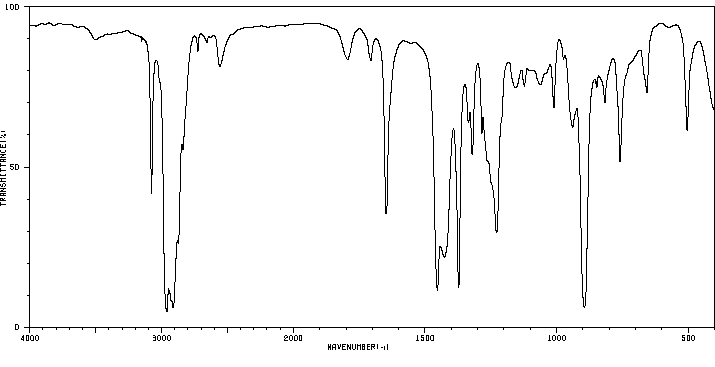2-甲基-2-丙烯-1-硫醇 | 5954-68-7
中文名称
2-甲基-2-丙烯-1-硫醇
中文别名
——
英文名称
2-methyl-2-propenethiol
英文别名
2-methyl-2-propene-1-thiol;2-methylprop-2-ene-1-thiol;2-Methyl-2-propen-1-thiol;2-methyl-1-propene-thiol;3-thio-2-methylpropene;isobutylene sulfide;Methallyl mercaptan
CAS
5954-68-7
化学式
C4H8S
mdl
——
分子量
88.1735
InChiKey
UFJYVTQALAAQEQ-UHFFFAOYSA-N
BEILSTEIN
——
EINECS
——
-
物化性质
-
计算性质
-
ADMET
-
安全信息
-
SDS
-
制备方法与用途
-
上下游信息
-
文献信息
-
表征谱图
-
同类化合物
-
相关功能分类
-
相关结构分类
物化性质
-
沸点:92.4-92.6 °C
-
密度:0.851±0.06 g/cm3(Predicted)
计算性质
-
辛醇/水分配系数(LogP):1.8
-
重原子数:5
-
可旋转键数:1
-
环数:0.0
-
sp3杂化的碳原子比例:0.5
-
拓扑面积:1
-
氢给体数:1
-
氢受体数:1
SDS
上下游信息
-
下游产品
中文名称 英文名称 CAS号 化学式 分子量 3-(甲硫基)-2-甲基丙烯 2-methyl-3-(methylthio)-1-propene 52326-10-0 C5H10S 102.2
反应信息
-
作为反应物:描述:2-甲基-2-丙烯-1-硫醇 以59%的产率得到参考文献:名称:MIXAJLOVA, T. V.;VYSOTSKAYA, L. E.;GREN, A. I., VINITI 501-85摘要:DOI:
-
作为产物:描述:参考文献:名称:Geiss,K.-H. et al., Chemische Berichte, 1977, vol. 110, p. 1833 - 1851摘要:DOI:
文献信息
-
[EN] MACROCYCLES AS PIM INHIBITORS<br/>[FR] MACROCYCLES EN TANT QU'INHIBITEURS DE PIM申请人:AMGEN INC公开号:WO2014022752A1公开(公告)日:2014-02-06The invention relates to compounds of formula (1), and salts thereof. In some embodiments, the invention relates to inhibitors or modulators of Pim-1 and/or Pim-2, and/or Pim-3 protein kinase activity or enzyme function. In still further embodiments, the invention relates to pharmaceutical compositions comprising compounds disclosed herein, and their use in the prevention and treatment of Pim kinase related conditions and diseases, preferably cancer.该发明涉及式(1)的化合物及其盐。在某些实施例中,该发明涉及Pim-1和/或Pim-2以及/或Pim-3蛋白激酶活性或酶功能的抑制剂或调节剂。在更进一步的实施例中,该发明涉及包含本文所披露的化合物的药物组合物,以及它们在预防和治疗与Pim激酶相关的疾病和病症,尤其是癌症中的用途。
-
Synthesis and configurational assignment of episulphoxides作者:K. Kondo、A. NegishiDOI:10.1016/s0040-4020(01)98185-2日期:1971.1spectra. By the analyses, based on the anisotropy effect of sulphinyl function and aromatic solvent induced shift (ASIS), we concluded that these episulphoxides obtained by our procedure have anti-configuration with respect to the substituent(s) and sulphinyl oxygen. Episulphoxides bearing an alkyl substituent and oxygen on the same side of the three-membered ring were quite unstable at room temp. Intramolecular
-
Thermal rearrangements of allyl 2,2-dichlorovinyl and 1,2,2-trichlorovinyl sulfides作者:Enkou Nagashima、Kunio Suzuki、Minoru SekiyaDOI:10.1016/s0040-4039(01)90527-1日期:1981.1Unique rearrangements of allyl 2,2-dichlorovinyl and 1,2,2-trichlorovinyl sulfides have been found. On heating the former gave 1,2-dichloro-l,4-pentadienes and the latter 2,3-dichloro-5-chloromethyl-4,5-dihydrothiophenes and 3,5,6-trichloro-3,4-dihydro-2H-thiopyranes .
-
The synthesis of 4′-thia-α-santalene and 4′-thia-α-santalol through an organometallic approach作者:Alessandro Mordini、Sabina Pecchi、Giuseppe CapozziDOI:10.1016/s0040-4020(01)90455-7日期:1994.1The 4′-thia analogues of α-santalene and α-santalol are prepared in a very convenient, regio- and stereocontrolled manner by using allyl type organometallic intermediates.
-
Nonenzymatic Stereoselective <i>S</i>-Glycosylation of Polypeptides and Proteins作者:Li-Qiang Wan、Xia Zhang、Yike Zou、Rong Shi、Jin-Ge Cao、Shi-Yang Xu、Li-Fan Deng、Li Zhou、Yanqiu Gong、Xiaoling Shu、Ga Young Lee、Haiyan Ren、Lunzhi Dai、Shiqian Qi、K. N. Houk、Dawen NiuDOI:10.1021/jacs.1c05156日期:2021.8.11nonenzymatic glycosylation reaction that builds axial S-glycosidic bonds under biorelevant conditions. This strategy is enabled by the design and use of allyl glycosyl sulfones as precursors to glycosyl radicals and exploits the exceptional functional group tolerance of radical processes. Our method introduces a variety of unprotected glycosyl units to the cysteine residues of peptides in a highly selective
表征谱图
-
氢谱1HNMR
-
质谱MS
-
碳谱13CNMR
-
红外IR
-
拉曼Raman
-
峰位数据
-
峰位匹配
-
表征信息
同类化合物
铜,丙烷-2-硫醇
铅,丙烷-1-硫醇
苏-(2R,4R)-戊二硫醇
羟基-乙醛
硫甘油
癸烷-2-硫醇
甲硫醇铅
甲硫醇钠
甲硫醇-d4
甲硫醇-S-d
甲硫醇
甲三硫醇
环辛硫醇
环戊硫醇
环戊基甲硫醇
环庚烷-1,1-二硫醇
环己硫醇
环己烷-1,1-二硫醇
环己基甲硫醇
环十二烷硫醇
环丙硫醇
环丙基甲硫醇
环丁硫醇
油烯基硫醇
氟甲硫醇
氘代甲硫醇-D3
正十四烷基硫醇
末端脱氧核苷酸转移酶
戊赤藓四硫醇
戊烷-3-硫醇
异戊硫醇
异戊烯基硫醇
异丙硫醇
异丁硫醇
庚-3-烯-4-硫醇
己-2-烯-1-硫醇
巯基甲烷-13C
巯基乙醛
巯基乙胺氢溴酸盐
巯基乙胺
巯基-十一胺盐酸盐
壬烷-2-硫醇
吡啶,2-(戊基硫代)-,1-氧化
叔壬基硫醇
叔十六硫醇
叔十二烷硫醇
叔丁基硫醇
反式-2-丁烯-1-硫醇
双(巯基环戊烷)四氯化钛
半胱胺盐酸盐







